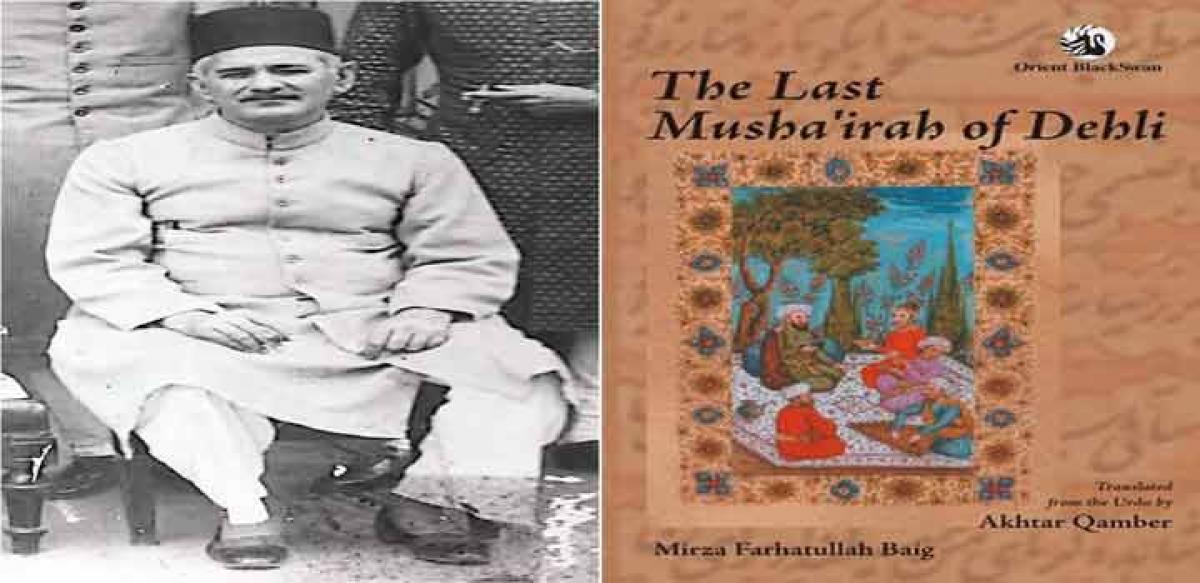Live
- Train crew suspended for violating speed limit
- Scrap NITI Aayog, bring back Planning Commission: Mamata
- Know your MLA: Satya Prabha continues husband’s legacy with resounding victory
- Dharani Revamp on Cards: CM calls for in-depth study to resolve Dharani lapses
- Huge scam in government ads
- NITI Aayog to focus on ‘Viksit Bharat @2047’
- PM playing petty politics: Oppn
- Jagan government destroyed AP economy says Chandrababu Naidu
- On Kargil Vijay Diwas, Modi hails Agnipath, targets Opposition
- War Of Words Over Kaleshwaram: Uttam accuses KTR of spreading lies
Just In

Mirza Farhataullah Baig is not a writer whose name triggers recognition beyond the limited circle of formal students of Urdu or a few others deeply interested in its rich literature, but he pioneered a vibrant variant of historical fiction in Indian letters - which has not even been emulated, let alone bettered. And it is unfortunate that his ‘Dehli Ki Aakhri Shama’, instead of being esteemed as a
Mirza Farhataullah Baig is not a writer whose name triggers recognition beyond the limited circle of formal students of Urdu or a few others deeply interested in its rich literature, but he pioneered a vibrant variant of historical fiction in Indian letters - which has not even been emulated, let alone bettered. And it is unfortunate that his ‘Dehli Ki Aakhri Shama’, instead of being esteemed as a literary treasure, is scarcely even known.
Initially serialised in an Urdu literary newspaper in 1927 before coming out in book form, it is not only Urdu prose at its best, but, as said, pioneering a new form of fiction writing about the past, a form which does not focus on rulers, warriors, or saints but cultural figures, or seek to be a sweeping narrative from beginning to end, but only depicts a brief episode - though with rich detail and colour.
A vivid snapshot of a 19th century Delhi cultural extravaganza
The work purports to be an account of a 'mushairah' held in Delhi in 1845, with blessings of emperor Bahadur Shah Zafar - who himself can't attend due to court etiquette but sends a ghazal to be read out - and featuring the likes of Mirza Asadullah Khan 'Ghalib', Sheikh Ibrahim 'Zauq', and Hakim Momin Khan 'Momin' but also Nawab Mustafa Khan 'Shefta', Mufti Sadruddin Khan 'Azurda' and Lala Balmukand 'Johar', and many other good poets whose reputations haven't endured and others not so capable.
For Baig (1883-1947), who hailed from a distinguished Delhi family, it was a heartfelt paean to a golden age of the city he was born in but not fated to live much or die in. Educated at Delhi Madrasa (later Delhi College), Hindu College, and St Stephens College, he was an excellent science student and sportsman (cricket and football), who wanted to become an engineer but only found a job in the Nizam's Hyderabad. There he worked in the education department and later in the courts, ending up as a high court registrar, and died there in April 1947.
A gifted writer of prose, frequently humorous, he said he was inspired to write this after coming across a pen-portrait of 'Momin' in some old papers. “Immediately the idea struck me that I should arrange a gathering of poets at a mushairah on the pattern devised by the late Muhammad Hussain Azad in his book 'Nairang-e-Khayal', but instead of offering a commentary on the poets' works I should present the poets themselves as living and moving personalities." But stuck for a device in which those of different periods could be brought together, he decided to portray last of the Urdu poets of Mughal Delhi, before the events of 1857 irredeemably changed everything.
Baig not only drew on Azad's magisterial ‘Ab-e-Hayat’, which changed the format of 'tazkirahs' or accounts of Urdu poets, which had cursory biographical details and a few representative verses, to a more comprehensive one with more information of the poet as a person and placing him in a style and epoch, and Maulvi Karim-ud-Din 'Maghfoor's ‘Tabquat-ul-Shoara-e-Hind’ about an actual mushairah held in 1845.
And it is Karim-ud-Din who is put to service as a narrator and co-organiser of the mushairah whose genesis, planning, preparation and execution are described here. A native of Panipat, he runs a small printing press in Delhi, which is not doing well and decides to make it more paying by organising this to cash on the craze for Urdu poetry which affected "everybody from the king down to the beggar".
Approaching a more connected acquaintance, Nawab Zain-ul-Abedin Khan 'Arif', for help proves to be wise for Arif, a nephew of Ghalib, not only takes charge of the arrangements but his name helps in persuading even reluctant poets to attend.Though the 'mushairah' itself occupies most of the work, the planning and preparations are no less engrossing and throw vivid light on the language, etiquette, customs and geography of mid-19th century Delhi, and the personas and mannerisms of some of Urdu's greatest poets.
And then the event not only provides a unique setting for some of their greatest ghazals - be it Ghalib's "Dil-e-nadaan tujhe hua kya hai", Momin's playful "Ulte voh shikve karte hai", and, above all, Zafar's ghazal with its immortal sher: "Na thi haal ki jab hamen apni khabar, rahe dekhte auron ke aib-o-hunar/Padi apni buraiyon pe nazar, to nigah mein koi bura na raha".
Not knowing Urdu is not a bar to enjoying this work. "The Last Mushairah of Delhi" is Lucknow-born academician Akhtar Qamber's English translation but while she provides extensive background, she went a bit far in translating the poetry too, while Farooq Argali has prepared a transliteration (with copious explanations) in Devanagri script.
By:Vikas Datta

© 2024 Hyderabad Media House Limited/The Hans India. All rights reserved. Powered by hocalwire.com







